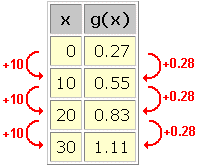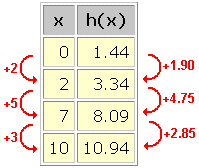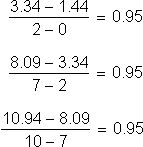Linear Functions
Numeric Representation![]()
|
|
To recognize a linear trend in a data set, we make use of the key algebraic property of linear functions
![]()
We can read this equation this way: If the input x is increased by a constant interval (Dx), then the output f(x) will also increase by a constant interval (bDx).
For data sets with constant intervals between inputs, this is an easy pattern to recognize:

In this data set, we see a linear trend with
We arrive at the following model for this data set:
This equation can be used to interpolate or extrapolate further data values.
What if a data set has not been recorded at equal intervals of the input? We can rewrite the key algebraic property this way:
![]()
This form of the equation can be read: Whatever the increase in input (Dx) between two data points, the slope remains constant (b).
We can recognize this pattern even in data sets without constant intervals between the inputs:

Nothing looks constant at first, but when we calculate the slopes we find:

The constant slope
|
|
|
| Back to Contents | |